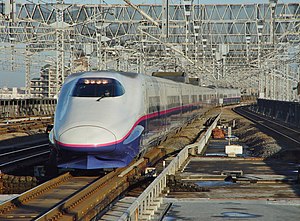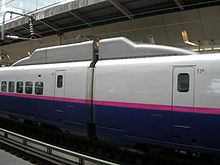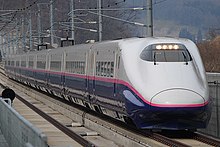Shinkansen series E2
| Shinkansen series E2 | |
|---|---|
|
Series E2
|
|
| Number: | N variant: 14 J variant: 39 |
| Manufacturer: | Kawasaki HI , Hitachi , Nippon Sharyo, Tokyu Car Corporations |
| Year of construction (s): | 1995-2010 |
| Retirement: | since 2013 |
| Gauge : | 1435 mm ( standard gauge ) |
| Length over coupling: | 201.4 m (N variant) 251.4 m (J variant) |
| Length: | End car: 25,700 mm Middle car: 25,000 mm |
| Height: | 3,700 mm 4,475 mm (including pantograph cover) |
| Width: | 3,380 mm |
| Trunnion Distance: | 17,500 mm |
| Bogie axle base: | 2,500 mm |
| Payload: | 366 t (N variant) 440 t (J variant) |
| Top speed: | 275 km / h (Tōhoku) 260 km / h (Nagano) 240 km / h (Jōetsu) |
| Continuous output : | 7,200 kW (N variant) 9,600 kW (J variant) |
| Acceleration: | 1.6 km / h / s |
| Wheel diameter: | 860 mm |
| Power system : | 25 kV 50 Hz / 60 Hz ~ |
| Power transmission: | Overhead line 2 pantographs |
| Number of traction motors: | 24 (N variant) 32 (J variant) |
| Brake: | Engine brakes , disc brakes |
| Train control : | ATC-2, DS-ATC |
| Seats: | 51/579 (N variant), (1st / 2nd class) 51/763 (J variant) |
| Floor height: | 1,300 mm |
| Classes : | normal (2nd class), Green Class (1st class) |
The Shinkansen series E2 ( Japanese 新 幹線 E2 系 電車 , Shinkansen E2-kei densha ) is a Japanese high-speed train that was built between 1995 and 2005 and is used on the Tōhoku and Jōetsu Shinkansen routes . Until 2017 it was also operated with 8-car sets on the Hokuriku Shinkansen . The vehicles can be tensioned with 8 or 10 trolleys. The 10-car trains can also be coupled with the Shinkansen series E3 .
The top speed of the E2 is 275 km / h, but the Jōetsu Shinkansen only drives at 240 km / h.
variants
8-car N series
The fleet of 13 N-series vehicles was developed for the new Asama connection on the Hokuriku Shinkansen. The first units were delivered between March 1997 and September 1997. These trains were designed for both 50 Hz and 60 Hz. From April 2014, the N series of the E2 series was used together with the new Shinkansen series E7 on the Asama connections. In 2017 the last set was taken out of service and the E2 series was withdrawn from the Hokuriku Shinkansen.
| Car no. | 1 | 2 | 3 | 4th | 5 | 6th | 7th | 8th |
|---|---|---|---|---|---|---|---|---|
| Labelling | T1c | M2 | M1 | M2 | M1k | M2 | M1s | T2c |
| numbering | E223 | E226-100 | E225 | E226-200 | E225-400 | E226-300 | E215 | E224 |
| Seating capacity | 55 | 100 | 85 | 100 | 75 | 100 | 51 | 64 |
Cars 4 and 6 were equipped with PS205 pantographs.
Duration
| Car number | delivery date | Manufacturer | Retirement | Remarks |
|---|---|---|---|---|
| N1 | June 6, 1995 | - | July 9, 2014 | Pre-production vehicle S6 |
| N2 | March 25, 1997 | Kawasaki HI | September 1, 2014 | |
| N3 | April 16, 1997 | Hitachi | 1st December 2014 | |
| N4 | April 25, 1997 | Kawasaki HI | April 23, 2014 | |
| N5 | May 14, 1997 | Nippon Sharyo | June 1, 2017 | |
| N6 | May 29, 1997 | Hitachi | 17th June 2014 | |
| N7 | June 13, 1997 | Nippon Sharyo | January 25, 2016 | |
| N8 | June 27, 1997 | Kawasaki HI | May 26, 2014 | |
| N9 | July 11, 1997 | Hitachi | September 26, 2014 | |
| N10 | July 25, 1997 | Nippon Sharyo | 17th February 2016 | |
| N11 | August 8, 1997 | Hitachi | August 1, 2014 | |
| N12 | August 25, 1997 | Tokyu Car Corporation | April 2, 2014 | |
| N13 | September 5, 1997 | Kawasaki HI | May 11, 2017 | |
| N21 | April 14, 1995 | - | January 6, 2015 | Pre-production vehicle S7, then initially as J1 |
10-car J-series (E2 'series)
The J-series was designed to be used in traction with the E3 series between Tokyo and Morioka for the opening of the new Akita Shinkansen . The end cars in the direction of Morioka had a coupling behind an automatically opening front hatch. The sets of the J-series initially consisted of eight cars.
Like the N series, these cars were equipped for both 50 Hz and 60 Hz power supplies and were also used for the Hokuriku Shinkansen before the series was extended to ten cars. Four J-series units were integrated into the Jōetsu Shinkansen in October / November 1998 . Between September and December 2002 all J-series units (except J1) were extended from eight to ten cars. The original red stripe on the side has been replaced by a magenta one. The last set was retired in August 2019.
| Car no. | 1 | 2 | 3 | 4th | 5 | 6th | 7th | 8th | 9 | 10 |
|---|---|---|---|---|---|---|---|---|---|---|
| Labelling | T1c | M2 | M1 | M2 | M1k | M2 | M1 | M2 | M1s | T2c |
| numbering | E223 | E226-100 | E225 | E226-200 | E225-400 | E226-300 | E225-100 | E226-400 | E215 | E224-100 |
| Seating capacity | 55 | 100 | 85 | 100 | 75 | 100 | 85 | 100 | 51 | 64 |
Cars 4 and 6 were equipped with PS205 pantographs.
Duration
| Wagon number | delivery date | Manufacturer | Conversion to 10 cars | Retirement |
|---|---|---|---|---|
| J1 | April 14, 1995 | - | (Pre-production vehicle S7, re-classified as N21 in October 2002) | - |
| J2 | December 20, 1996 | Hitachi | December 19, 2002 | 2nd October 2013 |
| J3 | January 24, 1997 | Hitachi | December 24, 2002 | October 30, 2013 |
| J4 | February 12, 1997 | Kawasaki HI | September 19, 2002 | February 8, 2016 |
| J5 | March 3, 1997 | Nippon Sharyo | October 29, 2002 | June 12, 2014 |
| J6 | March 17, 1997 | Nippon Sharyo | November 3, 2002 | May 2, 2014 |
| J7 | October 5, 1998 | Nippon Sharyo | November 16, 2002 | August 21, 2017 |
| J8 | October 20, 1998 | Hitachi | September 24, 2002 | May 31, 2018 |
| J9 | November 23, 1998 | Nippon Sharyo | September 14, 2002 | April 8, 2016 |
| J10 | December 17, 1998 | Kawasaki HI | October 14, 2002 | 18th February 2017 |
| J11 | September 6, 1999 | Nippon Sharyo | November 21, 2002 | January 9, 2019 |
| J12 | September 17, 1999 | Tokyu Car | September 29, 2002 | 23 August 2019 |
| J13 | October 5, 1999 | Hitachi | October 4, 2002 | April 27, 2018 |
| J14 | October 19, 1999 | Kawasaki HI | October 19, 2002 | 7th November 2018 |
| J15 | November 5, 1999 | Tokyu Car | October 24, 2002 | 17th May 2019 |
10-car E2-1000 series
The prototype of the E2-1000 sub-series (unit J51) was transferred to the depot in Sendai as an 8-car set in December 2000 and after a test phase it was taken into regular service in November 2001. Unit J52 was already taken over as a 10-car set and used from July 2002 to December 2002 on the Tōhoku Shinkansen. A total of 14 units were handed over on schedule by 2005. The trains of the E2-1000 series gradually replaced the aging Shinkansen series 200 of the JR East on the new Hayate connection of the Tōhoku Shinkansen since December 2002 .
Several design improvements have been made to the E2-1000 series compared to the earlier series. The biggest change was made to the windows. The small windows (which were in each row of seats) gave way to wide windows similar to the E4 row trains. A new single-arm pantograph, resembling a wing in shape, was used to reduce noise. The pre-production unit J51 was equipped with automatic couplings at both ends. In addition, new sliding doors were used for these units. While the J51 was still delivered in the old paint scheme like earlier E2 series trains, the units from J52 onwards were already given the new paint scheme with a purple stripe.
Since 2019, the series has been gradually replaced on the Jōetsu Shinkansen by the E7 series and on the Tōhoku Shinkansen by the E5 series .
| Car no. | 1 | 2 | 3 | 4th | 5 | 6th | 7th | 8th | 9 | 10 |
|---|---|---|---|---|---|---|---|---|---|---|
| Labelling | T1c | M2 | M1 | M2 | M1k | M2 | M1 | M2 | M1s | T2c |
| numbering | E223-1000 | E226-1100 | E225-1000 | E226-1200 | E225-1400 | E226-1300 | E225-1100 | E226-1400 | E215-1000 | E224-1100 |
| Seats | 54 | 100 | 85 | 100 | 75 | 100 | 85 | 100 | 51 | 64 |
Cars 4 and 6 are equipped with PS207 pantographs.
Duration
| Wagon number | delivery date | Manufacturer | Retirement |
|---|---|---|---|
| J51 | January 13, 2001 | Hitachi / Kawasaki HI / Nippon Sharyo / Tokyu Car | March 13, 2019 |
| J52 | July 17, 2002 | Hitachi | |
| J53 | August 5, 2002 | Kawasaki HI | |
| J54 | March 8, 2003 | Kawasaki HI | |
| J55 | November 7, 2002 | Hitachi | |
| J56 | November 23, 2002 | Hitachi | |
| J57 | October 4, 2003 | Nippon Sharyo | |
| J58 | September 11, 2003 | Tokyu Car | |
| J59 | October 21, 2003 | Tokyu Car | |
| J60 | December 24, 2003 | Kawasaki HI | |
| J61 | January 17, 2004 | Nippon Sharyo | |
| J62 | February 2, 2004 | Kawasaki HI | |
| J63 | December 8, 2003 | Tokyu Car | |
| J64 | June 11, 2003 | Hitachi | |
| J65 | March 10, 2004 | Kawasaki HI | |
| J66 | April 6, 2005 | Nippon Sharyo | |
| J67 | June 7, 2005 | Hitachi | |
| J68 | July 10, 2005 | Hitachi | |
| J69 | December 5, 2005 | Kawasaki HI | |
| J70 | February 19, 2010 | Hitachi | |
| J71 | March 11, 2010 | Nippon Sharyo | |
| J72 | April 12, 2010 | Hitachi | |
| J73 | May 10, 2010 | Kawasaki HI | |
| J74 | June 7, 2010 | Kawasaki HI | |
| J75 | September 27, 2010 | Nippon Sharyo |
commitment
present
past
-
Hokuriku Shinkansen
- Asama connection
Furnishing
2 + 3 seat configuration in 2nd class with a seat pitch of 960 mm and 2 + 2 seat configuration in Green Class with a seat pitch of 1160 mm.
Test runs
A train of the E2-1000 series (J56) broke the speed record in April 2003 (as a Shinkansen in regular use, i.e. not a test train) in high-speed tests on the Urasa-Niigata section of the Jōetsu Shinkansen and reached 362 km / h.
Exports
China ordered several 250 km / h E2-1000 units, which were renamed to CRH2 . This makes the E2 the second Shinkansen to be exported after the 700T series . China ordered 60 units, the first 3 units were in Japan in the period 2001-2003, a further 6 units were prefabricated in Japan and finally assembled by Sifang Locomotive and Rolling Stock in China. The remaining 51 units were built directly by Sifang in China.
A joint venture program for a further 140 trains is also being planned.
See also
credentials
- JR 全 車 両 ハ ン ド ブ ッ ク 2006 (JR Rolling Stock Handbook 2006) . Neko Publishing, Japan 2006.
- Peter Semmens: High Speed in Japan: Shinkansen - The World's Busiest High-speed Railway . Platform 5 Publishing, Sheffield, UK 1997, ISBN 1-872524-88-5 .
Individual evidence
- ↑ a b c d e f 高速 鉄 道 物語 - そ の 技術 を 追 う - (Tale of high-speed traffic). Seizandō Syoten, Japan 1999, ISBN 4-425-92321-9 , p. 57





